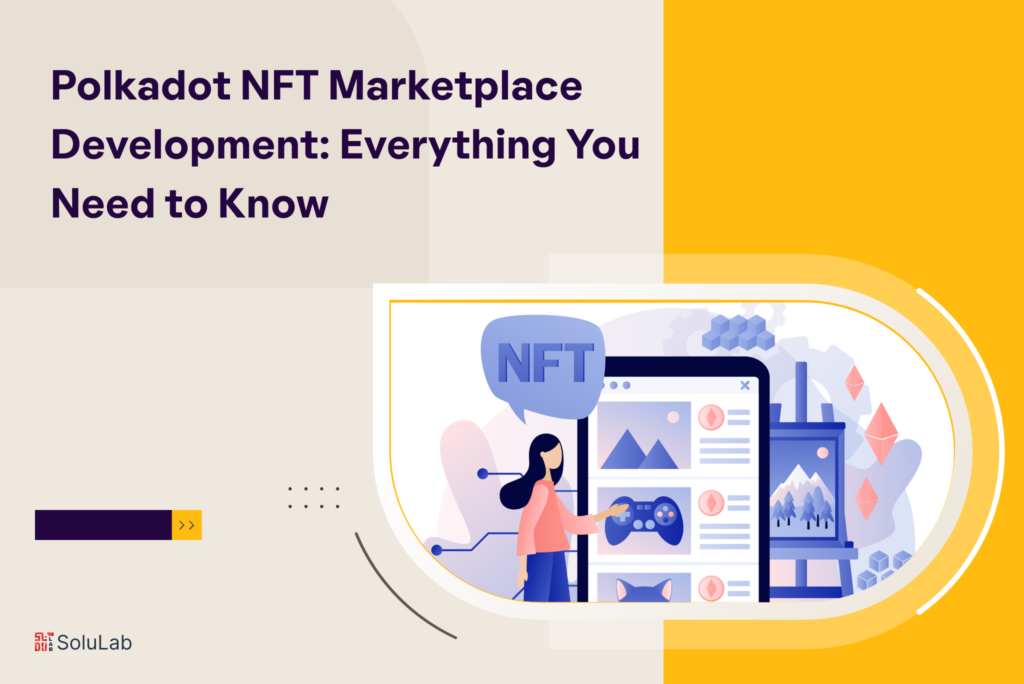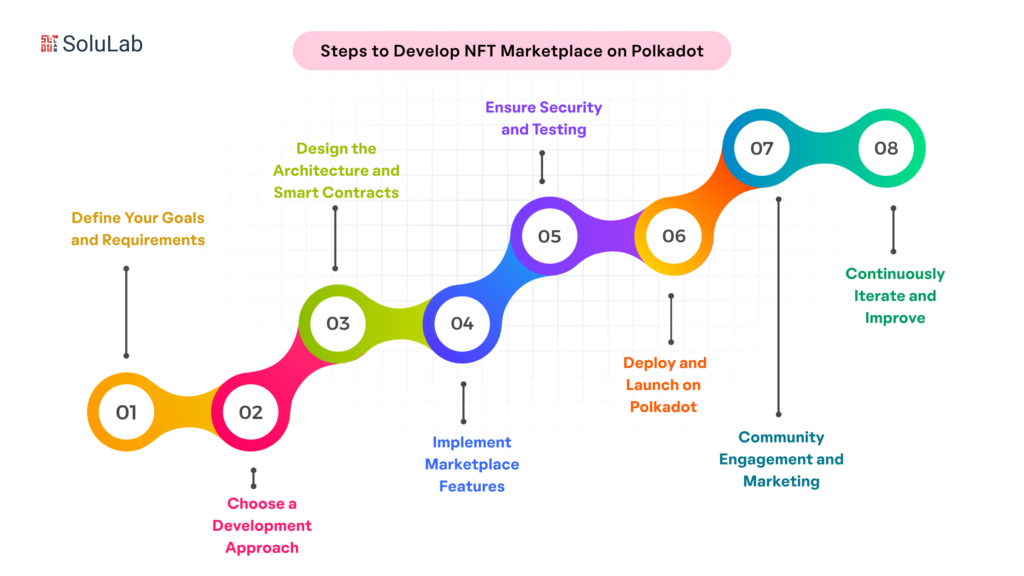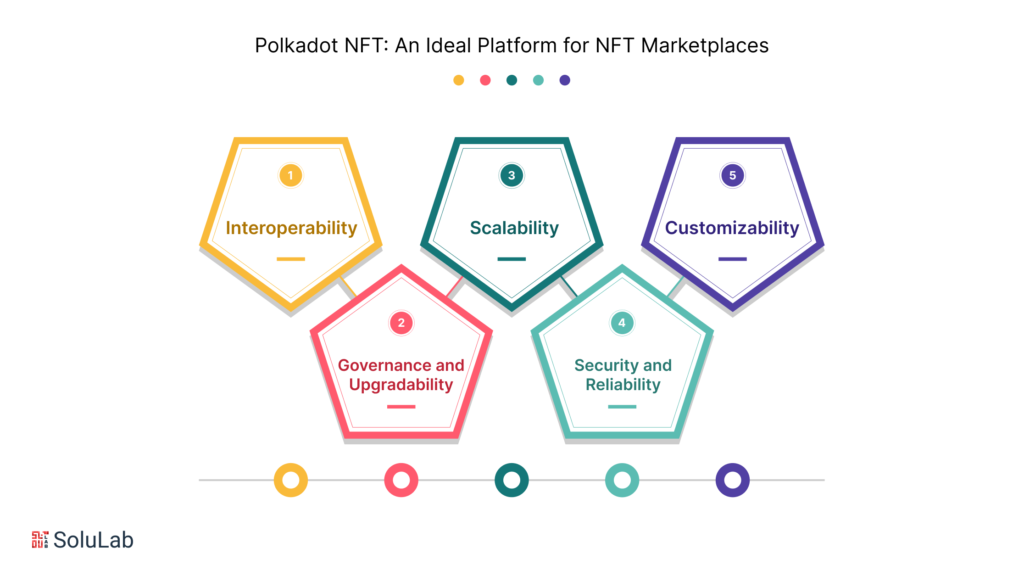
In the ever-evolving landscape of blockchain technology, Non-Fungible Tokens (NFTs) have captured the attention of creators, collectors, and investors worldwide. These unique digital assets represent ownership or proof of authenticity for a wide range of digital and physical items. While NFTs have primarily gained popularity on Ethereum, the emergence of Polkadot, a multi-chain platform, has opened up exciting opportunities for NFT marketplace development.
Polkadot, known for its interoperability and scalability, provides a decentralized ecosystem that connects multiple specialized blockchains into one unified network. This unique architecture allows for seamless communication and transfer of assets between different chains, providing a fertile ground for NFT marketplace development. With its robust infrastructure and advanced technical capabilities, Polkadot offers developers a versatile platform to create secure, efficient, and innovative NFT marketplaces.
When it comes to Polkadot NFT marketplace development, several key features contribute to a successful and engaging user experience. These features may include a user-friendly interface, robust search and filtering options, secure and transparent transaction mechanisms, customizable storefronts for artists and creators, bidding and auction functionalities, royalty management systems, and social engagement tools. This blog will delve into everything you need to know about Polkadot NFT marketplace development, its advantages, key features, and the potential it holds for the future.
What is a Polkadot NFT Marketplace?
A Polkadot NFT marketplace is a digital platform built on the Polkadot blockchain network that facilitates the buying, selling, and trading of Non-Fungible Tokens (NFTs). NFTs are unique digital assets that represent ownership or proof of authenticity for various types of digital or physical items, such as artwork, collectibles, virtual real estate, music, and more.
In a Polkadot NFT marketplace, users can explore a wide range of NFT collections, discover unique digital assets, and engage with artists, creators, and other collectors. These marketplaces typically offer a user-friendly interface, advanced search and filtering options, and customizable storefronts for artists to showcase their work. Users can browse through different categories, view detailed information about each NFT, and interact with the community through comments, likes, or social media integration.
Read Also: Cardano Vs Polkadot Vs Solana
One of the key advantages of a Polkadot NFT marketplace is its scalability. Unlike blockchain networks that face challenges with network congestion and high transaction fees, Polkadot’s architecture allows for high transaction throughput without compromising speed or cost-effectiveness. This scalability ensures a smooth and efficient user experience, enabling seamless buying, selling, and trading of NFTs within the marketplace.
Furthermore, Polkadot’s interoperability is another crucial aspect of a Polkadot NFT marketplace. It enables cross-chain communication and asset transfers between different blockchains, expanding the possibilities for creators and collectors.
Security is paramount in a Polkadot NFT marketplace. The decentralized nature of the Polkadot network, combined with the use of smart contracts, ensures the integrity and immutability of NFT transactions. Additionally, platforms often implement robust security measures such as encryption protocols, two-factor authentication, and regular smart contract audits to provide a safe and trustworthy environment for users.
How to Develop NFT Marketplace on Polkadot?

Developing an NFT marketplace on Polkadot is an exciting endeavor that allows you to tap into the potential of the platform’s interoperability and scalability. Here are the key steps to follow when developing an NFT marketplace on Polkadot:
-
Define Your Goals and Requirements
Start by clarifying your project goals and identifying the specific requirements for your NFT marketplace. Consider factors such as target audience, desired features, user experience, and any unique value propositions you want to offer.
-
Choose a Development Approach
Determine whether you want to build your NFT marketplace from scratch or leverage existing frameworks or protocols. Polkadot provides a variety of options, including Substrate, a framework for creating customized blockchains, and the Polkadot Parachain Development Kit (PDK), which streamlines the development of parachains on the Polkadot network.
-
Design the Architecture and Smart Contracts
Define the architecture of your NFT marketplace, including the front-end user interface, back-end systems, and smart contracts. Smart contracts play a crucial role in NFT marketplaces, governing the creation, ownership, and trading of NFTs. Utilize the Polkadot ecosystem’s tools and libraries to implement smart contracts tailored to your marketplace’s requirements.
-
Implement Marketplace Features
Develop the core features of your NFT marketplace, such as user registration and authentication, NFT listing and browsing, transaction handling, bidding and auction functionalities, wallet integration, and search capabilities. Consider additional features like royalty management, social engagement tools, and gamification elements to enhance user engagement and differentiate your marketplace.
Read Also: Avalanche NFT Marketplace Development : A Complete Guide
-
Ensure Security and Testing
Implement robust security measures to protect users’ assets and data. Perform comprehensive security audits, including code reviews and vulnerability assessments, to identify and address potential security risks. Thoroughly test the functionality and performance of your NFT marketplace to ensure a smooth user experience and identify and fix any bugs or glitches.
-
Deploy and Launch on Polkadot
Deploy your NFT marketplace on the Polkadot network as a para chain or by integrating with existing Polkadot parachains. Consider the various deployment options available on Polkadot and choose the one that aligns with your project goals and technical requirements.
-
Community Engagement and Marketing
Once your NFT marketplace is live, focus on building a vibrant community around it. Engage with artists, collectors, and users through social media, forums, and events. Implement strategies to attract users and artists to your platform, such as partnerships, promotional campaigns, and incentives.
-
Continuously Iterate and Improve
The development of an NFT marketplace is an iterative process. Collect feedback from users and artists, and make ongoing improvements to enhance the user experience, add new features, and address any emerging needs or challenges. Stay updated with the latest developments in the Polkadot ecosystem and leverage new technologies and advancements to keep your marketplace competitive.
Why is Polkadot NFT an Ideal Platform for Developing NFT Marketplaces?

Polkadot is an ideal platform for developing NFT marketplaces due to its unique features and advantages. Here are the key reasons why Polkadot NFT is a favored choice for developers:
-
Interoperability
Polkadot’s primary strength lies in its interoperability. It is designed to connect multiple blockchains, known as parachains, into a unified network. This interoperability allows NFT marketplaces built on Polkadot to seamlessly interact with other chains, enabling cross-chain asset transfers and expanding the range of available NFTs.
Artists and collectors can tap into a broader ecosystem, leveraging assets from different chains and attracting a diverse user base.
-
Scalability
Scalability is a critical factor for NFT marketplaces, as they require fast and efficient transaction processing. Polkadot addresses scalability challenges by utilizing a unique architecture called a relay chain and parachains. The relay chain serves as the central hub, while parachains handle specific functions.
This architecture enables Polkadot to process a high volume of transactions in parallel, resulting in faster confirmations and a smooth user experience. Polkadot’s scalability ensures that NFT marketplaces can handle increased user activity and support the growing demand for NFT transactions.
-
Customizability
Polkadot offers developers significant flexibility and customizability. With Substrate, a framework for building blockchains, developers can create tailored parachains specific to their NFT marketplace requirements.
This allows for the development of unique features, customization of smart contracts, and optimization of the desired user experience. Developers can leverage Polkadot’s modular design to create a marketplace that stands out in terms of functionality, user interface, and overall design.
Read Also: Everything You Need to Know About Metaverse NFT Marketplace Development
-
Governance and Upgradability
Polkadot’s governance model empowers the community to participate in decision-making processes. Through a mechanism known as on-chain governance, stakeholders can vote on protocol upgrades, parameter changes, and network management.
This decentralized governance ensures that the platform evolves with the consensus of the community, providing a robust and sustainable ecosystem for NFT marketplaces. Upgradability is crucial in the fast-paced world of NFTs, as marketplaces need to adapt to changing trends, technology advancements, and user needs.
-
Security and Reliability
Polkadot prioritizes security and reliability. It utilizes a shared security model, where the security of all parachains is upheld by the consensus of the Polkadot network. Additionally, Polkadot’s design enables secure and trustless transactions through its use of advanced cryptography and smart contracts.
By leveraging Polkadot’s infrastructure, NFT marketplaces can ensure the integrity and immutability of transactions, providing users with a safe and secure environment to buy, sell, and trade NFTs.
What are the Initial Steps in Building a Polkadot NFT Marketplace?

Building a Polkadot NFT marketplace requires careful planning and execution. Here are the initial steps to consider when embarking on this exciting endeavor:
-
Define Project Goals and Requirements
Start by clearly defining the goals and objectives of your Polkadot NFT marketplace. Determine the purpose of the marketplace, whether it’s to cater to a specific niche, support a particular type of NFTs, or provide a unique user experience.
Identify the key features and functionalities you want to include, such as user registration, NFT listing, bidding, auction, wallet integration, and social engagement tools. Clearly outlining your project requirements will serve as a foundation for the development process.
- Identify the Target Audience
Understand your target audience and their specific needs and preferences. Consider the interests and behaviors of NFT collectors, artists, and enthusiasts who will be using your marketplace.
Research existing Polkadot NFT marketplaces and identify any gaps or opportunities to differentiate your platform. By having a clear understanding of your target audience, you can tailor your marketplace’s features and design to meet their expectations and provide a compelling user experience.
-
Determine the Technical Requirements
Assess the technical requirements for building your Polkadot NFT marketplace. Decide whether you want to build your marketplace from scratch or leverage existing frameworks or protocols like Substrate or Polkadot Parachain Development Kit (PDK).
Consider factors such as development resources, expertise, timeline, and budget when making this decision. Evaluate the scalability and interoperability features provided by Polkadot, as these will play a crucial role in the success of your marketplace.
Read Our Blog: BSC NFT Marketplace Development: Everything you Need to Know
-
Plan the Marketplace Architecture
Design the architecture of your Polkadot NFT marketplace. Consider the front-end user interface, back-end systems, and database structure. Determine how NFTs will be stored, minted, and traded on the Polkadot network.
Plan the integration of smart contracts to handle the creation, ownership, and trading of NFTs. Carefully consider security measures, such as encryption protocols and authentication mechanisms, to ensure the integrity and safety of user transactions and data.
-
Develop a Roadmap and Timeline
Create a development roadmap and timeline to guide your progress. Break down the project into manageable milestones and prioritize essential features for the initial release. Consider allocating resources for quality assurance, testing, and security audits.
A well-structured roadmap will help you stay organized, monitor progress, and meet key deliverables throughout the development process.
-
Assemble a Skilled Development Team
Building a Polkadot NFT marketplace requires a talented and experienced development team. Look for professionals with expertise in blockchain development, smart contract development, front-end and back-end programming, and user experience design.
Collaborating with a team that understands the intricacies of Polkadot and NFT marketplaces will ensure a smoother and more efficient development process.
-
Engage with the Polkadot Community
Join the Polkadot community and engage with other developers, artists, and enthusiasts. Participate in forums, attend meetups or conferences, and connect with like-minded individuals.
By being an active member of the community, you can gain valuable insights, gather feedback, and establish partnerships that can contribute to the success of your Polkadot NFT marketplace.
Conclusion
In conclusion, Polkadot NFT marketplace development represents a dynamic and promising avenue for exploring the potential of blockchain technology and non-fungible tokens (NFTs). Polkadot, with its innovative multi-chain framework and interoperability features, offers a unique ecosystem for creating NFT marketplaces that are secure, scalable, and connected to various blockchain networks.
The Polkadot network’s ability to facilitate cross-chain communication and asset transfers opens up exciting possibilities for NFT marketplace development. By leveraging Polkadot’s Substrate framework and its para-chain infrastructure, developers can build NFT marketplaces that transcend the limitations of a single blockchain, allowing for seamless interoperability and a diverse range of NFT collections from different networks.
One of the key advantages of Polkadot NFT marketplace development lies in its enhanced scalability and transaction throughput. The network’s shared security model, combined with its sharding and parallel processing capabilities, enables efficient handling of a high volume of transactions, ensuring smooth and uninterrupted user experiences.
SoluLab, a leading Polkadot Blockchain Development company, is here to unlock the immense potential of cross-chain platforms by seamlessly uniting multichain and permissionless information transfers at unprecedented speeds. With their skilled experts, they can help businesses and startups build top-notch NFT marketplaces from scratch, catering to various needs like artwork, digital collectibles, gaming, asset tokenization, and more. SoluLab’s NFT marketplace development services are known for their feature-rich solutions and meticulous approach. Contact SoluLab today to elevate your business with cutting-edge NFT solutions.
FAQs
1. What is Polkadot NFT marketplace development?
Polkadot NFT marketplace development refers to the process of creating a digital platform on the Polkadot blockchain network that facilitates the buying, selling, and trading of non-fungible tokens (NFTs). These marketplaces provide a secure and efficient environment for artists, collectors, and enthusiasts to interact with and transact NFTs, leveraging the capabilities and interoperability features of the Polkadot network.
2. Why is Polkadot an ideal choice for NFT marketplace development?
Polkadot offers several advantages that make it an ideal choice for NFT marketplace development. Firstly, Polkadot is a multi-chain network that allows different blockchain networks, known as parachains, to interoperate. This interoperability enables cross-chain NFT transfers and collaborations, expanding the potential user base and liquidity of NFT marketplaces. Additionally, Polkadot’s scalable infrastructure ensures high performance, low transaction fees, and fast transaction confirmations, enhancing the user experience within NFT marketplaces.
3. What are the key features of a Polkadot NFT marketplace?
A Polkadot NFT marketplace typically incorporates essential features such as user registration and authentication, NFT listing and browsing functionalities, secure and transparent smart contract integration, wallet integration for seamless token transfers, auction and bidding mechanisms, royalty management systems, and a robust search and filtering system.
4. How does Polkadot NFT marketplace development differ from other blockchain networks?
Polkadot NFT marketplace development distinguishes itself through the unique characteristics of the Polkadot network. Unlike other blockchain networks, Polkadot is designed to facilitate interoperability and communication between multiple blockchain networks, allowing NFT marketplaces to leverage assets and capabilities from different chains.






